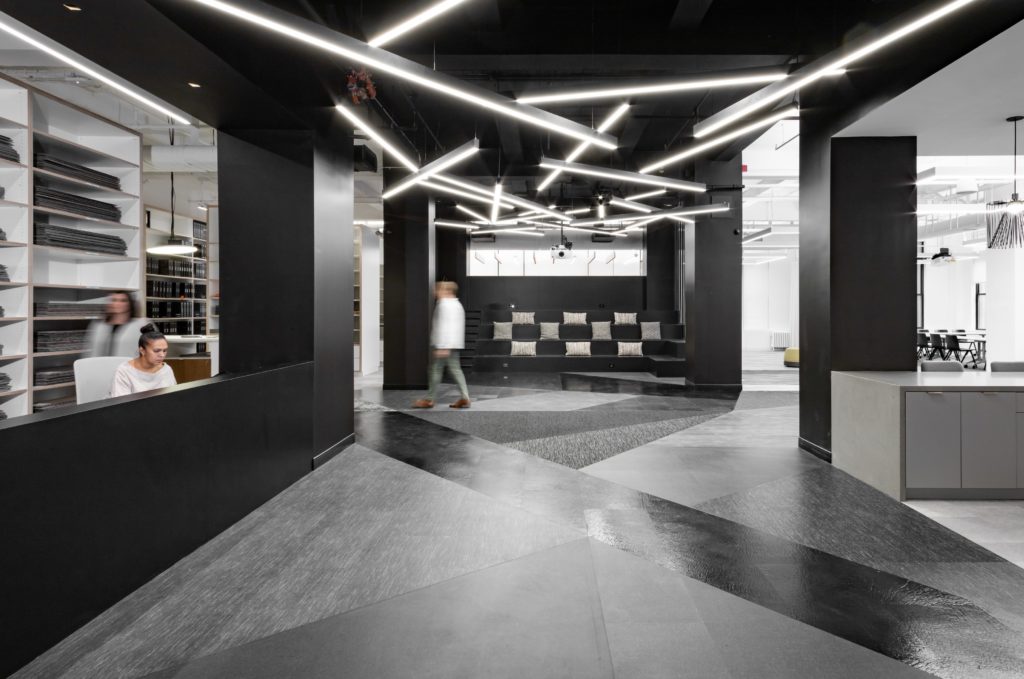New York—Tarkett officially opened its 10,000-square-foot Atelier here last week. The goal of the studio, which was designed by Huntsman Architectural Group, is to offer a modular, “co-creation workspace” that could inspire collaboration and creativity between the flooring and A&D communities.
Tarkett’s new Atelier offers the opportunity for users to experience all the company’s solutions in one space. The facility houses a variety of flooring platforms, including LVT, broadloom, modular carpet, Powerbond, rubber, Lino, VET, SVT and vinyl sheet. Huntsman Architectural Group was also tasked with creating a space to highlight Tarkett’s focus on design collaborations and the maker community and integrate a variety of customizable “zones” denoted by floor color and product, color temperature tunable lighting fixtures, textural drapery and access to natural light. The resulting design highlights a range of Tarkett innovations for all projects.
Melissa Dallal, project manager, interior design, Memorial Sloan Kettering Cancer Center, supported Tarkett’s use of the space as well as the inclusion of multiple flooring categories. “I’m looking to refresh a pediatrics area of our hospital—and seeing how they installed this vignette with messaging is very helpful,” she told GO. “It has given me ideas to take with me in the design process.”
In conjunction with the grand opening, Tarkett hosted the first of several curated panel discussions and exhibits scheduled for the coming year. The inaugural panel, “Circular by Design,” featured the following presenters: Jessica Schreiber of Fabscrap; designers Suzanne Tick; Zero Waste Daniel; as well as Dhruv Raina, Tarkett’s director of sustainability. The panel members—led by moderator and trend analyst Philip Fimmano of Edelkoort—discussed circular systems within their practices, challenges and what they hope the future holds for sustainable design.
As to why the manufacturer chose circular systems, Raina told FCNews the idea of sustainability is still not emotionally connecting to the consumer. The first discussion/exhibit was meant to help bridge that gap. “We wanted to show that human aspect of recycling and repurposing and show there are possibilities if you are able to collaborate and innovate,” he explained.
Collaboration, Raina added, is a pillar upon which the success of sustainability in the flooring sector will rest. “In the flooring industry, everybody has their own kingdom in the sense that somebody is good at carbon reduction, someone else at material health and another at recycling,” he told FCNews. “It’s not easy because everybody wants to be seen as a thought leader, but we need to scale up these best practices.”
More importantly, Raina noted, the industry needs to collaborate. “How do we have that communication channel that connects us so we’re not looking for a needle in a haystack? We need more open innovation—an incubator kind of environment where we can meet once a week or once a month and share these best practices. I think that’s the only way to grow our impact.”
Raina added that the A&D community has helped move the needle, but education is still required. “Nobody wakes up thinking, ‘I want to design a space that is going to be harmful to people in 100 years,’” he said. “But we need to give the A&D community those tools—the education to identify the holistic impact of anything the designer chooses. It’s a lot from our part that’s remaining to be done, and a lot from their part from a learning perspective. But, really, it’s about collaboration again.”
Memorial Sloan Kettering’s Dallal agreed that sustainability is an important topic to discuss within the industry. She said sustainable products have become pretty pervasive within healthcare environments. “When we’re designing, that’s the palette we limit ourselves to,” she explained. “We’re only pulling sustainable products. Healthcare tends to be more ahead in terms of things like that.”

